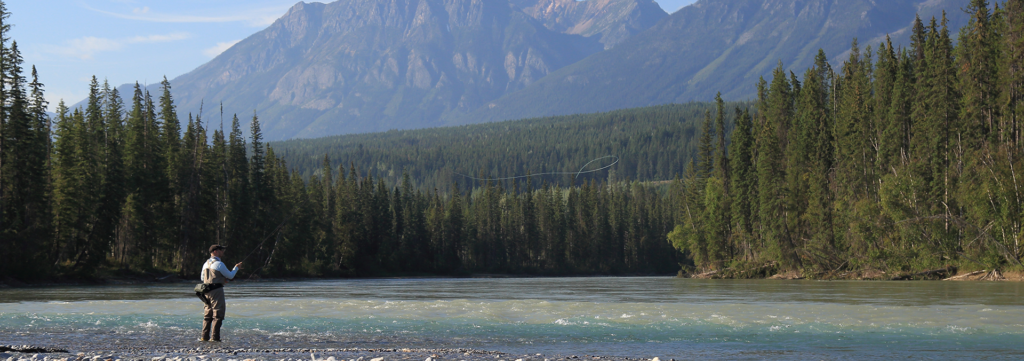You stare intently at your dry fly as it drifts past along a seam in the current. The water suddenly bulges beneath it. You catch a glimpse of white gums just before a trout engulfs the fly and darts away. You lift your rod tip … feel the satisfying weight of your quarry … fish on!
Anglers young and old, new and seasoned, are eager to share vivid memories like this of dry-fly fishing a favourite stream. But for many starting out in this kind of angling, even fooling a fish, or setting the hook on a rising fish, can be frustrating. The following five tips should help.
1. Leader setup and casting
Tapered leaders are essential for dry-fly fishing. The smooth tapering from thick line (where you attach it to your heavy fly line) to thin line (where you tie your fly) allows the fly to lay on the water straight out from the fly line. A long, untapered leader usually piles up into loose coils on the water. Even if the coils don’t spook the fish, there will be too much slack in the leader to set the hook.
There are many lengths and sizes of tapered leaders available. I’d start with a 2.7-metre (nine-foot) leader that tapers to a fine 4X (around six-pound-test). Tie on an additional 60 to 90 centimetres (two to three feet) of 4X or even finer 5X (about four-pound-test) monofilament line as a “tippet” to which you tie your fly.
To start, try casting your dry fly across the current. Cross current is the easiest way to control the drift of the fly, and to set the hook if a fish hits. You can also cast directly upstream or downstream, but these two approaches require a little more experience.

2. Presentation of the dry fly
The presentation of your fly is as important as the fly you choose. Most often, a dry fly needs to float drag-free (also known as a dead drift). By comparing the fly’s drift to the foam on the surface, a dry fly floats drag-free when it moves at the same pace as the surface current.
If you have no success with a drag-free presentation (especially when fishing with Stimulators or Elk Hair Caddis), then add a little twitch, or start skating your fly to attract the attention of fish. To twitch a fly, raise your rod tip and gently wiggle it. To skate a fly, cast across and slightly downstream, and let the fly swing across the surface.

3. Pick the right fly
When trout feed on the surface, they often target a specific kind of insect. Take the time to observe what is hatching. Seeing what fish are taking is obvious if there is a big hatch taking place, but sometimes you need to carefully examine what’s dropping onto the water from vegetation along the shoreline. Once you have an idea what insect is available, pick a pattern that most closely resembles it from your fly box. First, try to match the size, then the profile and colour. If you are close in size and shape, you will fool a few fish.
With literally hundreds of dry-fly patterns, choosing the right one can be confusing. Start with well-known dry patterns like the Adams (mayflies) in sizes 12 to 16, Orange Stimulators (stoneflies) in sizes 8 to 10, and Elk Hair Caddis (caddisflies) in sizes 10 to 14. These patterns will cover most dry-fly fishing situations. As you gain more experience, you can start to incorporate specific flies (like Western Green Drakes or Pale Morning Duns) to more closely “match the hatch.”

4. Target rises
When you get to a river and several fish are rising, make a note of where each fish is rising. Start by targeting fish along the edges and at the bottom of the run. Gradually work your way upstream and to the centre of the run. Try to pick off one fish at a time – cast one metre (three feet) upstream from where the fish rose, and let your fly drift into its feeding zone. This approach allows you to maximize your chances with each fish without spooking the other fish you want to target later.

5. Setting the hook
When a fish takes your fly on the surface, adrenaline causes many anglers to lift the rod tip too soon and too hard, pulling the fly away. When a fish rises to your fly, wait for a moment to allow the fish enough time to take your fly into its mouth. Now set the hook by simply lifting the rod tip just enough to tighten the line, and let the downward momentum of the fish do the actual hookset. Then, all you need to do is lift the rod tip to keep the line tight, enjoy the ride, and make new fishing memories.
Author: Danie Erasmus
Photo Credit: Frisco Saint, Danie Erasmus
Danie Erasmus lives in Prince George. In his spare time, he writes articles about fishing on streams, and operates a website: www.princegeorgeflyfisher.com dedicated to educating anglers about fly fishing. Danie also teaches a number of fly-fishing courses that range from beginner to more advanced levels.
Follow Danie on Facebook and Instagram.
